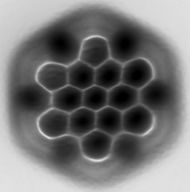
Back هيدروكربون عطري متعدد الحلقات Arabic Çox dövrlülər Azerbaijani Hidrocarbur aromàtic policíclic Catalan Polyaromatické uhlovodíky Czech Aromatiske kulbrinter Danish Polycyclische aromatische Kohlenwasserstoffe German Policikla aromata hidrokarbonido Esperanto Hidrocarburo aromático policíclico Spanish Polütsüklilised aromaatsed süsivesinikud Estonian Hidrokarburo aromatiko polizikliko Basque
Three representations of hexabenzocoronene, a polycyclic aromatic hydrocarbon. Top: standard line-angle schematic, where carbon atoms are represented by the vertices of the hexagons and hydrogen atoms are inferred. Middle: ball-and-stick model showing all carbon and hydrogen atoms. Bottom: atomic force microscopy image.
A polycyclic aromatic hydrocarbon (PAH) is a class of organic compounds that is composed of multiple aromatic rings. The simplest representative is naphthalene, having two aromatic rings, and the three-ring compounds anthracene and phenanthrene. PAHs are uncharged, non-polar and planar. Many are colorless. Many of them are found in coal and in oil deposits, and are also produced by the incomplete combustion of organic matter—for example, in engines and incinerators or when biomass burns in forest fires.
Polycyclic aromatic hydrocarbons are discussed as possible starting materials for abiotic syntheses of materials required by the earliest forms of life.[1][2]


